Learning from Las Vegas: The Costs of Growth
by Daniel Wortel-London
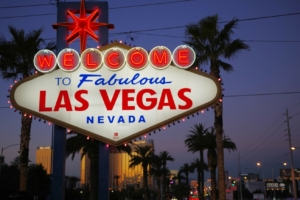
The city of Las Vegas is gambling with growth—but the game is rigged. (LasVegasGuy, Creative Commons 4.0)
Since 1998, the City of Las Vegas and the U.S. Bureau of Land Management (BLM) have been gambling with nature. By auctioning off public land from the BLM for development and using the proceeds to preserve natural areas, policymakers and federal officials have bet that development and conservation can go hand-in-hand.
But it hasn’t worked out that way.
As the Las Vegas region has grown from 1.3 to 2.7 million people since 1998, it has suffered from the effects of sprawl, drought, and air pollution. And the ecological consequences of the city’s growth have largely canceled out the “conservation” provisions of federal-regional land use agreements.
The result is a local case that brings to life a much larger lesson: Maintaining the earth’s biocapacity and accelerating growth are mutually exclusive goals. By learning from Las Vegas, we can assemble the evidence and identify the coalitions needed to contest planet-wrecking growth policies across the country.
Selling Public Land
The BLM, which manages about one-tenth of the land area of the USA, is one of the most important federal agencies involved in public land sales. The Federal Land Policy Management Act of 1978, or FLPMA, sets many of the requirements and procedures for such sales.
It specifies that the BLM can select lands for sale if, as determined through a land-use planning process, they meet one of three criteria: 1) lands are scattered, isolated tracts that are difficult or uneconomic to manage; 2) they were acquired for a specific purpose and are no longer needed for that purpose; or 3) disposal of the land would serve important public objectives such as community expansion and economic development.
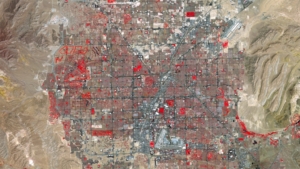
Satellite view of Las Vegas. The city’s sprawl is abetted by federal aid. (Goddard Space Flight Center)
In the last criterion, the meanings of “public objective,” “community expansion,” and “economic development” are critically important. But they are not defined clearly in the Act itself nor in the BLM’s Land Exchange Handbook. The best clue regarding BLM’s understanding of the terms is found in how it has managed actual cases of development. Las Vegas provides an excellent example.
The 1998 Southern Nevada Public Land Management Act (SNPLMA) provides the federal legislative template for aligning the interests of developers and conservationists in the region. The purpose of the bill was to “provide for the orderly disposal of certain federal lands in Clark County, Nevada, and to provide for the acquisition of environmentally sensitive lands in the State of Nevada.” It aims to accomplish this by drawing a boundary around the Las Vegas Valley and identifying public lands to be sold at auction to private bidders, while allowing the proceeds of those sales to be used to purchase “environmentally sensitive” land elsewhere.
In some ways the bill seems to have worked as planned. Some 34,468 acres of public land have been sold or exchanged for development purposes. This has provided $2.6 million dollars for environmentally sensitive land acquisitions, $17 million for miscellaneous conservation activities, and $54 million for park development. That’s a win-win, right?
The Costs of Growth
Wrong. First, not all money raised through land sales has been spent for environmental purposes. Funds have been used to build everything from shuffleboard courts to softball complexes, $60 million gun clubs, and a $5 million neon-sign museum. They’ve also paid for the parking lots, roads, and power lines leading to these amenities, all of which means more resource throughput.
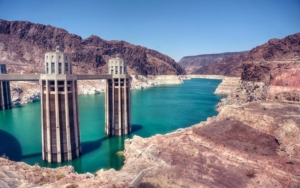
Las Vegas’s growth is putting pressure on the Colorado River, as evidenced by the bathtub rings near Hoover Dam. (Peter Theony, Creative Commons 2.0)
The biggest issue isn’t the use of money from land sales, it’s the use of the land purchased from the sales—specifically, the spawning of sprawling housing and commercial developments. Technically, local governments could request land sales only by demonstrating that the land’s use would follow comprehensive and “smart” plans. But planners in Las Vegas have, for the most part, been content to approve the kinds of automobile-centric plans that characterize much of America’s development around cities.
As a result, Las Vegas now suffers the ecological, fiscal, and social costs of sprawl. Worsened air quality, less open space, longer commutes, and poorer health all afflict the metropolis. The upkeep of Nevada’s roads alone now costs the state $10 billion annually, spurred partly by Las Vegas’s growth. Pollution-induced asthma rates among African-American youth in the city are now 30%. A lack of public transit prevents many citizens from accessing badly needed jobs and housing.
Overshadowing these ills is an even bigger malady: climate change. The Las Vegas Valley receives fewer than 5 inches of rainfall per year on average and relies largely on water drawn from the Colorado River to meet residential, industrial, and commercial demand. But the river is stressed by record droughts—droughts that will be exacerbated by the climate change accelerated by Las Vegas’s cars as the city sprawls ever-outward. Already, Las Vegas is one of the fastest-warming cites in the country, having experienced 5.7°F of average temperate rise over the past 70 years.
Round 2
Yet the drive to further plunder public land for the sake of growth continues. In 2021 a Democratic senator introduced legislation modeled on the SNPLMA that would effectively double the amount of real estate the BLM could sell to Nevada developers. A metropolitan area the size of Miami—42,427 acres, or approximately 65 square miles—will become available for sprawl in the Las Vegas region.
Nonetheless, many conservationists have supported the bill thanks to its provisions for habitat preservation—again, modeled on the SNPLMA. For example, the bill would conserve about 2 million acres of public land, add more than 1.6 million acres of wilderness, add 350,000 acres to Southern Nevada’s conservation portfolio, and permanently save the Red Rock National Conservation Area from development.
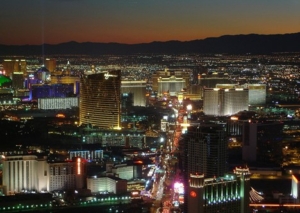
Fabulous Las Vegas—but for how much longer? (BrendelSignature, Creative Commons 3.0)
Thus, groups like the Las Vegas Metro Chamber of Commerce, the Nevada Conservation League, the Conservation Fund, and the Southern Nevada Homebuilders Association have aligned to support the self-contradictory “Southern Nevada Economic Development and Conservation Act.”
But not everyone is on board with the bill, and many opponents are sounding off to the media. The Nevada Climate Justice Coalition, comprised of social and ecological advocacy organizations, has united to fight it. They argue that the bill’s conservation measures are outweighed by its ecological costs. “While we support protecting public lands, designating a bunch of wilderness areas does nothing to ameliorate the climate or justice impacts of sprawl. It’s a false equivalence,” says Patrick Donnelly of the Center for Biological Diversity in an interview with the Nevada Current. “It disregards our future water supply. It disregards emissions, vehicle miles traveled,” Kyle Roerink of the Great Basin Water Network told the paper in a separate interview.
Meanwhile, Janine Blaeloch, Project Director of the Western Lands Project, told National Public Radio, “It’s salt in the wound for American taxpayers. Because we’re losing public land that’s being sold off, we’re losing money that’s being funneled into supporting sprawl in Las Vegas, but we also are unwittingly supporting really unsustainable development in the middle of the desert.”
The political appeal of these critiques, however, appears to be limited. Few local politicians and fewer national ones have taken up the cause of curbing growth in Las Vegas. As law professor Bret Birdsong notes, “Growth is a hungry mouth to feed, and growth itself is an industry…I can understand how that takes almost immutable political forces to solve that problem. And here, the problem is solved by privatizing more public lands.” Thus, for most politicians in Nevada the solution to the problem of growth is—more growth.
This strange logic has bipartisan appeal. As Representative Mark Amodei, a Republican, states, “We’ll have our fights over conservation, development, water, that sort of thing. But at the end of the day, you don’t have to have a degree in finance to [know] what will happen if those tax bases go static… In all modern times, growth has been the cash flow for local government and the state.”
Underlying the political hesitation to critique growth is the element of partisan competition. Las Vegas has turned blue in recent years; a critique of growth by Democrats might jeopardize their newly attained power. Brian Petersen, an environmental scholar at Northern Arizona University, sums up the political reality: “If you start saying, all of a sudden, ‘We’re no longer giving out building permits, we’re no longer allowing multinational companies to build a facility here, we’re shutting down golf courses’—you would have people in the streets rioting.” The result is that, in the words of journalist Kyle Paoletta, “Even as Democrats lead the national charge toward tackling climate change, they are continuing to preach at the altar of growth.”
The Road Ahead
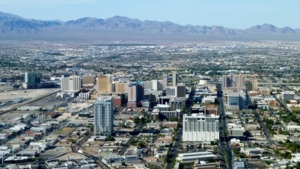
If Las Vegas is to have a future, it will need to stop growing. (Http2007, Creative Commons 2.0)
So, what is to be done? On one hand, the public can exert pressure to contest individual BLM land sales through public comment posts, letters to legislators, and letters to the editor. But the higher-level goal is to prevent public land sales from increasing environmental pressures to begin with. This can be done partly through more rigorous cost-benefit analysis of land sales to capture, for example, how much the ecological costs of sprawl would cancel out the conservation benefits of land preservation. But amendments to the Nevada bills must embed in them the true meaning of economic development and set true development as the bills’ chief goal and guiding principle.
None of this can happen, however, without assembling a strong political coalition. The Nevada Climate Justice Coalition, with its combination of social and ecological critiques of sprawl, provides a powerful model. Now is the time to support and expand their struggle by pointing out how other public policies on behalf of growth are also threatening people and the planet. But critique is not enough: We have to show how a degrowth-to-steady-state trajectory can not only avoid disaster, but actually improve outcomes for people.
Doing this will require research, persistence, and the courage to resist the blandishments of so-called “green” growth. I’m betting we’re up to the challenge.
Daniel Wortel-London is a Policy Specialist at CASSE.


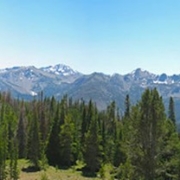
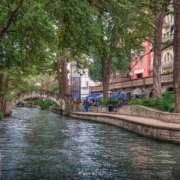


Ah, just saw this, apologies for not commenting sooner. All I can add is that indeed, Las Vegas is like Exhibit A in explaining that growth has costs, not just benefits. I’m hoping that lesson sinks in around the globe as quickly as possible.
This article powerfully highlights the environmental and social costs often associated with unbridled growth. The case of Las Vegas, with its dependence on resource extraction and strain on public services, serves as a stark reminder of the need for sustainable development practices.
The concept of a ‘steady state economy’ aiming for ecological balance is intriguing. Could you elaborate on potential policy mechanisms or economic incentives that could be implemented to encourage a transition towards a steady state model?